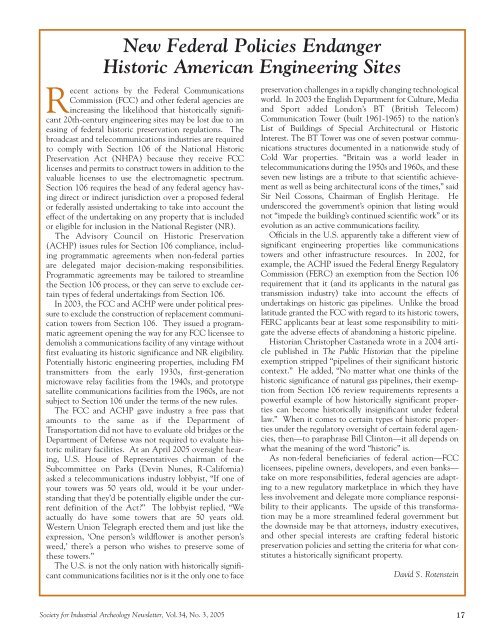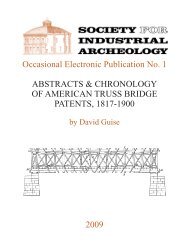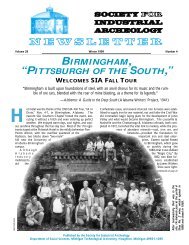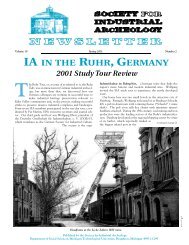SIAN - Society for Industrial Archeology
SIAN - Society for Industrial Archeology
SIAN - Society for Industrial Archeology
You also want an ePaper? Increase the reach of your titles
YUMPU automatically turns print PDFs into web optimized ePapers that Google loves.
New Federal Policies Endanger<br />
Historic American Engineering Sites<br />
Recent actions by the Federal Communications<br />
Commission (FCC) and other federal agencies are<br />
increasing the likelihood that historically significant<br />
20th-century engineering sites may be lost due to an<br />
easing of federal historic preservation regulations. The<br />
broadcast and telecommunications industries are required<br />
to comply with Section 106 of the National Historic<br />
Preservation Act (NHPA) because they receive FCC<br />
licenses and permits to construct towers in addition to the<br />
valuable licenses to use the electromagnetic spectrum.<br />
Section 106 requires the head of any federal agency having<br />
direct or indirect jurisdiction over a proposed federal<br />
or federally assisted undertaking to take into account the<br />
effect of the undertaking on any property that is included<br />
or eligible <strong>for</strong> inclusion in the National Register (NR).<br />
The Advisory Council on Historic Preservation<br />
(ACHP) issues rules <strong>for</strong> Section 106 compliance, including<br />
programmatic agreements when non-federal parties<br />
are delegated major decision-making responsibilities.<br />
Programmatic agreements may be tailored to streamline<br />
the Section 106 process, or they can serve to exclude certain<br />
types of federal undertakings from Section 106.<br />
In 2003, the FCC and ACHP were under political pressure<br />
to exclude the construction of replacement communication<br />
towers from Section 106. They issued a programmatic<br />
agreement opening the way <strong>for</strong> any FCC licensee to<br />
demolish a communications facility of any vintage without<br />
first evaluating its historic significance and NR eligibility.<br />
Potentially historic engineering properties, including FM<br />
transmitters from the early 1930s, first-generation<br />
microwave relay facilities from the 1940s, and prototype<br />
satellite communications facilities from the 1960s, are not<br />
subject to Section 106 under the terms of the new rules.<br />
The FCC and ACHP gave industry a free pass that<br />
amounts to the same as if the Department of<br />
Transportation did not have to evaluate old bridges or the<br />
Department of Defense was not required to evaluate historic<br />
military facilities. At an April 2005 oversight hearing,<br />
U.S. House of Representatives chairman of the<br />
Subcommittee on Parks (Devin Nunes, R-Cali<strong>for</strong>nia)<br />
asked a telecommunications industry lobbyist, “If one of<br />
your towers was 50 years old, would it be your understanding<br />
that they’d be potentially eligible under the current<br />
definition of the Act?” The lobbyist replied, “We<br />
actually do have some towers that are 50 years old.<br />
Western Union Telegraph erected them and just like the<br />
expression, ‘One person’s wildflower is another person’s<br />
weed,’ there’s a person who wishes to preserve some of<br />
these towers.”<br />
The U.S. is not the only nation with historically significant<br />
communications facilities nor is it the only one to face<br />
<strong>Society</strong> <strong>for</strong> <strong>Industrial</strong> <strong>Archeology</strong> Newsletter, Vol.34, No. 3, 2005<br />
preservation challenges in a rapidly changing technological<br />
world. In 2003 the English Department <strong>for</strong> Culture, Media<br />
and Sport added London’s BT (British Telecom)<br />
Communication Tower (built 1961-1965) to the nation’s<br />
List of Buildings of Special Architectural or Historic<br />
Interest. The BT Tower was one of seven postwar communications<br />
structures documented in a nationwide study of<br />
Cold War properties. “Britain was a world leader in<br />
telecommunications during the 1950s and 1960s, and these<br />
seven new listings are a tribute to that scientific achievement<br />
as well as being architectural icons of the times,” said<br />
Sir Neil Cossons, Chairman of English Heritage. He<br />
underscored the government’s opinion that listing would<br />
not “impede the building’s continued scientific work” or its<br />
evolution as an active communications facility.<br />
Officials in the U.S. apparently take a different view of<br />
significant engineering properties like communications<br />
towers and other infrastructure resources. In 2002, <strong>for</strong><br />
example, the ACHP issued the Federal Energy Regulatory<br />
Commission (FERC) an exemption from the Section 106<br />
requirement that it (and its applicants in the natural gas<br />
transmission industry) take into account the effects of<br />
undertakings on historic gas pipelines. Unlike the broad<br />
latitude granted the FCC with regard to its historic towers,<br />
FERC applicants bear at least some responsibility to mitigate<br />
the adverse effects of abandoning a historic pipeline.<br />
Historian Christopher Castaneda wrote in a 2004 article<br />
published in The Public Historian that the pipeline<br />
exemption stripped “pipelines of their significant historic<br />
context.” He added, “No matter what one thinks of the<br />
historic significance of natural gas pipelines, their exemption<br />
from Section 106 review requirements represents a<br />
powerful example of how historically significant properties<br />
can become historically insignificant under federal<br />
law.” When it comes to certain types of historic properties<br />
under the regulatory oversight of certain federal agencies,<br />
then—to paraphrase Bill Clinton—it all depends on<br />
what the meaning of the word “historic” is.<br />
As non-federal beneficiaries of federal action—FCC<br />
licensees, pipeline owners, developers, and even banks—<br />
take on more responsibilities, federal agencies are adapting<br />
to a new regulatory marketplace in which they have<br />
less involvement and delegate more compliance responsibility<br />
to their applicants. The upside of this trans<strong>for</strong>mation<br />
may be a more streamlined federal government but<br />
the downside may be that attorneys, industry executives,<br />
and other special interests are crafting federal historic<br />
preservation policies and setting the criteria <strong>for</strong> what constitutes<br />
a historically significant property.<br />
David S. Rotenstein<br />
17






